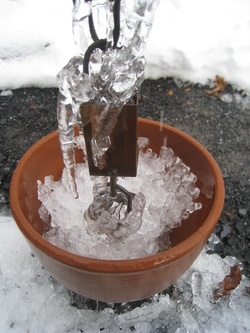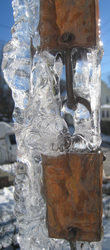|
It's Climate Week! Climate change has been in the news with folks young and old taking to public spaces around the globe to "strike" a chord with those in power to implement necessary climate-related policies, the United Nations General Assembly meeting in New York earlier in the week, and various organizations spreading the word on steps to take NOW including the American Society of Landscape Architects (ASLA) and so many more. But what does it all mean to us, in the Boston area? To find out more about work being done to prepare for climate change in our own backyard, see this interesting case study developed by the ASLA. Stoss Landscape Urbanism
0 Comments
Very informative story shedding light on America's rivers- history, use, climate change or so much more. Take a listen! The goal of the constructed wetland of the Alewife Reservation in Cambridge, MA, completed in 2013, is to clean storm water before it enters Boston Harbor. For more information see City of Cambridge Public Works, The Friends of Alewife Reservation Brochure and The Friends of Alewife Reservation Website.
The term “resilience” is bantered about a lot these days. But what does it mean in terms of landscape architecture? Due to climate change, the earth’s water levels are rising putting many communities at risk of flooding. Resilient landscapes aim to anticipate future water levels- preparing communities for the worst. That means incorporating green infrastructure so that storm water is absorbed into the ground instead of sent to potentially overcapacity piping systems or raising sensitive equipment above anticipated flood levels. I have been practicing this technique for many waterfront park projects in my work with the US Army Corps of Engineers for decades, designing public open spaces in Indiana and Ohio with annual flooding in mind. Recently, the EPA has begun to encourage planning for resiliency by way of the first National Disaster Resilience Competition, see the link for more specific detail and to learn about the cities and states that are benefiting from this innovative program.
 “No-Mow Lawn Seed” by Prairie Nursery in Westfield, Wisconsin is a low maintenance alternative to the traditional manicured seeded lawn. Much less maintenance is required since the blended seed selection is designed to incorporate only shorter grass blades. Mowing only one or two times each year is required and little if any water is needed once the lawn is established. I recently tried “No-Mow Lawn Seed” on a project and so far it is beautiful! For a longer, lush and informal lawn this alternative might be just what you’re looking for. http://www.prairienursery.com/store/no-mow-lawn-seed-mix-c-11.html Rain garden construction has begun! The area was laid out, a depression was dug, the soil was sifted to remove stones and boulders, a drain and cover was installed below the downspout, a drainage layer was installed, the existing soil was amended with high concentrations of organics including compost and cow manure and placed above the drainage layer, some iris were transplanted. We did not use filter fabric in this installation because of its tendency to clog over time. Next on the agenda- purchase and install rain chain, complete planting, replace adjacent pavement. Visit again for updates and to view progress.
For more information on the value of rain gardens as well as information about how to create your own, check out the links below. http://www.crwa.org/projects/bmpfactsheets/crwa_raingarden.pdf http://www.scdhec.gov/environment/water/swater/docs/RainGardenBrochure.pdf http://www.mass.gov/dfwele/der/riverways/pdf/raingardenfactsheet.pdf _ How do landscape architects store storm water on-site? One way is to employ porous or pervious pavements of which there are many varieties. Porous asphalt paving is a special mix of asphalt designed with aggregate sizes and binders that allow water to infiltrate into the soil layers below as opposed to being directed and piped to subsurface drainage systems. Wondering what it all looks like? On a recent cold and wet day, I took a trip to Walden Pond Reservation in Concord, Massachusetts to see for myself. Here you will see an installation of porous asphalt that has been in place since 1977!
Learn more by clicking on any of the links below. http://ciceet.unh.edu/unh_stormwater_report_2007/treatments/porous_asphalt/ http://www.millermicro.com/porpave.html http://www.concreteparking.org/ I attended a seminar called “Low Impact Development” in December 2011. What is Low Impact Development you ask? A definition provided by the Low Impact Development Center of Beltsville, Maryland states;Low Impact Development is a comprehensive land planning and engineering design approach with a goal of maintaining and enhancing the pre-development hydrologic regime of urban and developing watersheds
But what does this mean to the average citizen? In short- instead of collecting all rainfall (storm water) into underground pipes and then cleaning it in treatment facilitates, we collect as much rainfall as possible and store it on-site. We utilize soil and plants as filters which clean the water and then we re-use the cleaned water nearby. Low Impact Development can be less expensive than traditional piping techniques and it helps recharge local aquifers. For more detailed information about what’s involved, thumb through the Center’s website. There you’ll find references like publications and construction details as well as information about new projects implementing these strategies throughout the United States. http://www.lowimpactdevelopment.org/index.html |
Archives
September 2023
CateInspiration comes from the world around us; color, texture, pattern- all components of the ever changing landscape. The camera captures these moments for further reflection. This blog will feature monthly musings centered on the landscape. Categories
All
|























 RSS Feed
RSS Feed